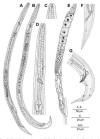 |
Female:
- Cuticle distinctly loose, 2.5 to 5 um thick, transversely striated,
annuli 0.2 to 0.5 um wide
- Longitudinal lines and lateral field indistinct.
- Lip region continuous with body contour. Labial sensilla
papilliform.
- Amphids inconspicuous.
- Stoma 0.6 to 1.2 labial diameter long. Cheilostom indistinguishable.
Gymnostom and stegostom fused to form weakly sclerotized funnel-shaped
chamber narrowing into pharyngeal lumen.
- Pharynx panagrolaimoid type with 57 to 70 um long, cylindrical
corpus, narrower 35 to38 um long isthmus and ovoid basal bulb with a
grinder and single-chambered haustrulum.
- Nerve ring encircling isthmus at 60 to 76% of pharyngeal length,
surrounding isthmus.
- Excretory pore located above nerve ring or at 44 to 57% of pharyngeal
length at posterior level of pharyngeal corpus.
- Cardia conoid, 2 to 4 um long.
- Reproductive system monodelphic, prodelphic; ovary dorsally
reflexed with distal end not reaching vulva.
- Spermatheca distinctly offset, oval, filled with sperms.
- Postuterine sac absent.
- Vulva�-anus distance about 2.8 to 4.4 times anal body diameter.
- Tail elongate, conoid with pointed terminus. Phasmids located at
middle of tail.
Male:
- Testis monorchic, ventrolaterally reflexed, on the right of
intestine; occasionally outstretched distally.
- Vas deferens narrowing into ejaculatory duct.
- Spicules stout, slightly ventrally curved with round capitula and
beak-like distal ends, 1.0-1.4 anal body diam. long.
- Gubernaculum lancet-shaped, proximallyhooked, 0.7-0.9 times
spicule length.
- Bursa absent.
- Caudal papillae seven pairs: two precloacal and five postcloacal
pairs
- Tail conoid tapering to a narrow pointed terminus.
Ref: Khan et al., 2012
|